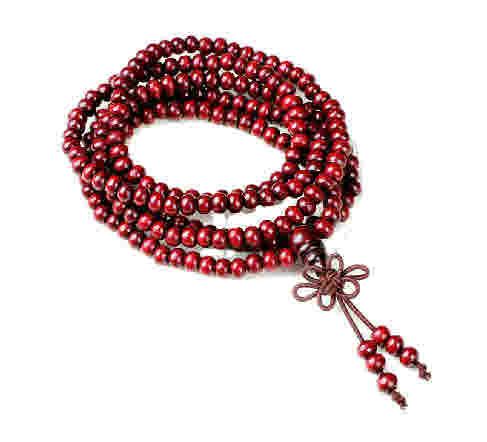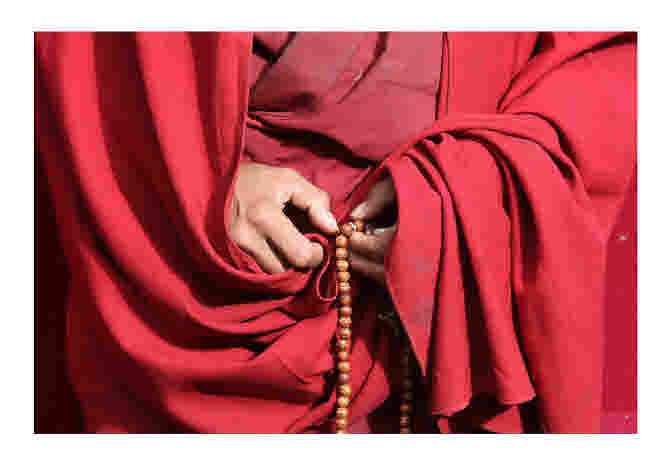|
|
Post by aceofcups on Feb 25, 2015 2:36:26 GMT
 On another thread we where talking about an ancient Tibetan bead which probably came from a string of mala beads. Like to share some information about Mala or Prayer beads: On another thread we where talking about an ancient Tibetan bead which probably came from a string of mala beads. Like to share some information about Mala or Prayer beads:
Buddhist prayer beads, traditionally called malas, first developed as a religious tool on the Indian continent. "The use of beads in prayer appears to have originated with Hindu religious practices in India. Buddhism, which developed from a sect of Hindu culture, retained the use of prayer beads as it became established in China, Korea, Japan, and Tibet."
The Buddha himself is believed to have instructed followers to utilize mala. "There is a Sutra (Buddhist Text aka. "thread of knowledge") in which a King prays to the Buddha for a simple practice to help ease his suffering from various difficulties and the Buddha responded by telling him to string 108 soapnut seeds and recite the three part refuge prayer upon them."
Buddhists normally utilize mala consisting of 108 beads, but the number may vary in different sects of Buddhism. Just like the Hindu variety, Buddhist mala consist of a strand of 108 beads (not including marker beads, decorative beads or guru bead), each a symbol of impurities and flaws that an individual must overcome.
108 beads is said to represent the following formula:
6 x 3 x 2 x3 = 108
6 senses of a human being: sight, sound, smell, taste, touch, thought
3 times: past, present, future
2 conditions of heart, mind or intention: pure or impure
3 disturbing emotional states or "kleshia": like, dislike, indifference
Malas are used for keeping count while reciting, chanting, or mentally repeating a mantra This practice is known in Sanskrit as japa.
Mantras are often repeated hundreds or even thousands of times. The mala is used so that one can focus on the meaning or sound of the mantra rather than counting its repetitions. One repetition is usually said for each bead while turning the thumb clockwise around each bead, though some traditions or practices may call for counterclockwise motion or specific finger usage. When arriving at the head bead, one turns the mala around and then goes back in the opposing direction. This makes using the mala easier as the beads will not be so tight on the string when you use them.

A similar process with it own repeated recitations and prayers in the West would be using the Rosary beads
|
|
sparklekaz
 Someone asked me.. What is your religion? I said, "All the paths that lead to the light".
Someone asked me.. What is your religion? I said, "All the paths that lead to the light".
Posts: 3,658
|
Post by sparklekaz on Feb 25, 2015 10:30:34 GMT
Hi ace,
This is very interesting. I've always thought that the 'mala beads' were similar to rosary beads. I have two questions. 1. Do you know what the 'refuge prayer' is. And if you do, could you share it here? 2. I have some rosary beads, and was wondering if I can use them in the Buddhist way, as well as the Catholic way, even though they only have 59 beads as opposed to the 108 mala beads?
Love and light
Kaz
|
|
|
|
Post by aceofcups on Feb 25, 2015 11:32:18 GMT
Namaste Karen,
As you know - Personalty I am not a traditionalist, I honor the Spirit within all religions, not dogma. I think intention and heart are more important then conditioned patterns, the Spirit of any discipline is more REAL to me then any ritual practice. So I would definitely say yes use rosary beads, no matter how many beads, do any prayers ,,, but do them loving with respect and alignment to the highest. If it doesn't seem to work, then maybe try the traditional rules, to see if that makes any difference. We are creating our spiritual path as we live it out.
The Three Refuges in Buddhism
One takes Refuge in the Three Jewels,, the Buddha, the Dharma, and the Sangha.
Traditional Refuge Prayers
I go for refuge to the Buddha,
I go for refuge to the Dharma,
I go for refuge to the Sangha.
or,
the Tibetan (Mahayana) version:
Until I am enlightened,
I go for refuge to the Buddha, Dharma and Sangha.
Through the virtue I create by practising giving and the other perfections,
may I become a Buddha (An Awakened Being) to benefit all sentient beings.
Refuge Prayer by Thich Nhat-Hanh
At the foot of the Bodhi tree, beautifully seated, peaceful and smiling,
the living source of understanding and compassion, to the Buddha I go for refuge.
The path of mindful living, leading to healing, joy, and enlightenment,
the way of peace, to the Dhamma I go for refuge.
The loving and supportive community of practice, realizing harmony, awareness, and liberation,
to the Sangha I go for refuge.
I am aware that the Three Gems are within my heart, I vow to realize them.
I vow to practice mindful breathing and smiling, looking deeply into things.
I vow to understand living beings and their suffering, to cultivate compassion and loving kindness,
and to practice joy and equanimity.
I vow to offer joy to one person in the morning and to help relieve the grief of one person in the afternoon.
I vow to live simply and sanely, content with just a few possessions, and to keep my body healthy.
I vow to let go of all worry and anxiety in order to be light and free.
I am aware that I owe so much to my parents, teachers, friends and all beings.
I vow to be worthy of their trust, to practice wholeheartedly,
so that understanding and compassion will flower,
and I can help living beings be free from their suffering.
May the Buddha, the Dhamma, and the Sangha support my efforts.
Here are some quick definitions of the Three Jewels:
THE BUDDHA
Buddha means enlightened State of Consciousness we all have, but also a state we have to awaken too. It is the the awakened or omniscient Oneness. A Buddha is a person who has purified their actions, emotions and thoughts and developed compassionate qualities to living. A Buddha is totally free from obscurations and karmic suffering after traveling the entire spiritual path. A Buddha started as an ordinary person and generated infinite compassion and equanimity to arrive at a state of highest bliss, and omniscience. But, as the Buddha himself said: "I cannot do but point the way".
THE DHARMA
Dharma (Sanskrit) or Dhamma (Pali) means doctrine, law or truth. The word Dharma has many different connotations, but in the Buddhist sense, it refers to "what holds back the mind from suffering", or the Buddha's teachings.
THE SANGHA
The Sangha refers to the spiritual community. It is defined in various ways. For myself I see it as fellow travellers no matter what tradition or religion, or no religion they align with. Just those dedicated to live a more spiritual life and it's wisdom. They are our spiritual friends who can help us stay on the right path and be open to allow us to share their and our own experiences.
Let me add here the Bodhisattva vow: "May I attain Buddhahood for the benefit of all sentient beings." A bodhisattva is one who strives to liberate all beings from the cycle of birth and death.
peace
aceofcups
|
|
sparklekaz
 Someone asked me.. What is your religion? I said, "All the paths that lead to the light".
Someone asked me.. What is your religion? I said, "All the paths that lead to the light".
Posts: 3,658
|
Post by sparklekaz on Feb 26, 2015 8:44:13 GMT
Thank you so much for this Ace.. the prayers are beautiful.  |
|
|
|
Post by aceofcups on Feb 26, 2015 15:39:30 GMT
Yesterday when meditating... a thought came up about my words in earlier part of this thread I had written, that I didn't complete my full thought. About following rules or not.
Do we have to follow exact rules,,, when doing spiritual practices? Probably depends on what they are. Here are just another 2 cents on it.
Certain rules were created because they create a certain type of exact energy pattern and results. Certain spiritual / magical rituals are like that. The key idea I was really trying to say was staying connected to the Present while doing spiritual disciplines and not getting caught in just doing them from conditioned memory. The full intent and results then can become less effective and less beneficial.
What came to mind, on a mundane level was baking bread lets say. And what is kneaded or needed  Sometimes you have to follow the exact rules of recipe, of exact amount of each ingredients, letting it rise for specific amount of time, exact temperature and being in oven the right amount of time etc. Of course, once one becomes a Master baker, and knowing all the variations of each step, then one can work with rules in new way I guess. Sometimes you have to follow the exact rules of recipe, of exact amount of each ingredients, letting it rise for specific amount of time, exact temperature and being in oven the right amount of time etc. Of course, once one becomes a Master baker, and knowing all the variations of each step, then one can work with rules in new way I guess.
But until that time -- I may stay with stir-fries for a while -- they are much more forgiving...lol
|
|






